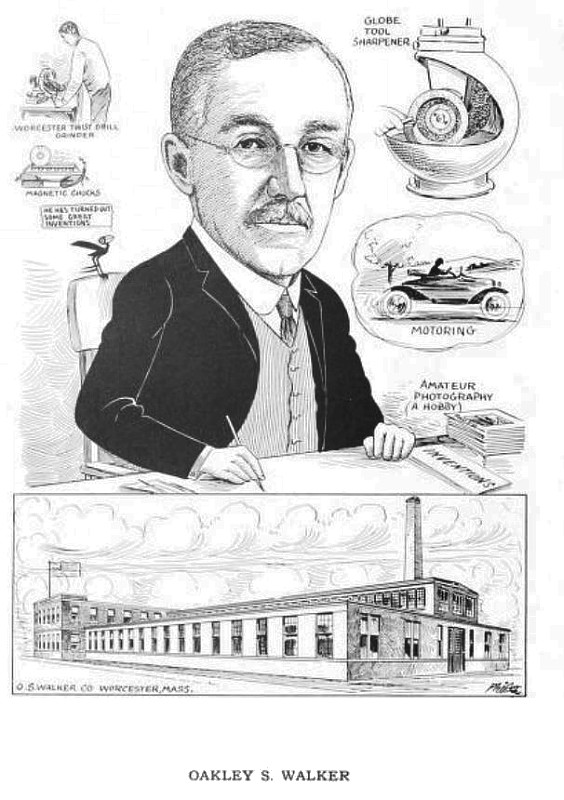
In 1896 with Oakley S. Walker invented the electromagnetic chuck, and founded the O.S. Walker Company in Worcester, Massachusetts.
Oakley Smith Walker
Founder, president and treasurer of the O.S. Walker Company, was born in South Rutland, Jefferson County, New York, Feb. 14, 1857, son of Benjamin F. and Ursula C. (Smith) Walker, both of whom were natives of South Rutland. His father was a cooper by trade and also followed farming. He served 3 years in the Civil War, dying of typhoid on his way to the front in 1864, leaving the mother with 5 young children without means of support.
Oakley S. Walker was adopted by his Uncle, and worked on a farm until he was 14 years old, when he began to work at the trade of wood-turning in a feather duster factory. Having saved a $100, he bought "his liberty" of his Uncle and since then has been self-supporting. He attended school at odd times, an at length apprenticed himself to learn the trade of machinist, serving 3 years, his pay averaging in that time less than a $1.00 a day. Then, after 2 terms in the high school, he worked at his trade. In the meantime his mother had qualified herself as a schoolteacher by attending the State Normal School and was teaching in the grammar grade. Afterward she was appointed to a State position. His next position was with the Eames Vacuum Brake Company of Watertown, New York, and he remained with this concern fo 5 years, the last of which he spent in England in charge of an experimental shop for testing railroad brakes.
Upon his return from abroad he went West and spent a year or more in various shops in Indiana and Ohio, thence going to New York City, remaining for a time, and finally to Watertown, his native city, where he began to manufacture drill grinding machinery of his own design in a small shop.
In 1887 he came to Worcester to arrange for the manufacture of some of his machine tools in the Washburn Shops of the Worcester Polytechnic Institute, when he accepted an attractive offer to enter the employ of the Washburn Shops, and he has made his home here since that time. He was for 3 years engaged in designing and developing machinery here. In the course of his work he perfected a successful twist drill grinding machine that has had a wide sale under the name of the Worcester Twist Drill Grinder. In 1890 he entered the employ of the Norton Emery Wheel Company and remained 7 years as designer, inventor and master mechanic. While there he designed machinery for truing emery wheels and also designed a tool grinding machine, the latter of which is now in universal use.
In 1897 Mr. Walker embarked in business with little capital, but with the nucleus of success in the invention of a magnetic chuck that holds machine parts while they are being finished on lathes, planers or grinding machines.
It was the first device of its kind, and proved highly successful when finally introduced. He has from time to time added the manufacture of other machines of his invention. From a one-man shop in rented quarters, the business has grown to large proportions. The business was moved from the Washburn Shops to the Porter Last Factory and in 4 years outgrew the two floors occupied there. In 1910 a large factory of concrete construction was built at Greendale. At that time Mr. Walker bought out his partner and in 1914 the business was incorporated under its present title, the O.S. Walker Company, of which he is president and treasurer; Isaac F. Williams, secretary and manager. The factory is spacious, well lighted and thoroughly modern. Mr. Walker is a member of the Worcester Country Club, and attends St. John's Protestant Episcopal Church, of which his family are members.
Information Sources
- The Massachusetts corporate registry database lists O. S. Walker Co.'s first registration as 1915-05-07.
- History of Worcester and Its People by Charles Nutt; Volume 4 page 726, Lewis Historical Publishing Company New York City 1919